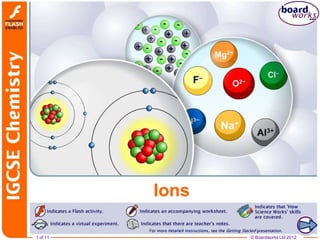
ions-171030062231.pptx
- 1. Ions 1 of 11 © Boardworks Ltd 2012
- 2. 2 of 11 © Boardworks Ltd 2012
- 3. What are bonds? 3 of 11 © Boardworks Ltd 2012 Elements are made up of just one type of atom, sometimes joined to other atoms of the same element by chemical bonds. This forms molecules such as chlorine (Cl2). Compounds are formed when different elements chemically react and form bonds with each other, e.g. water (H2O). Different types of bonds are formed depending on the types of atoms involved: ● ionic bonding occurs between metal and non-metal atoms. ● covalent bonding occurs between non-metals atoms only. All bonding involves changes to the number of electrons in the outer shells of atoms.
- 4. Why do atoms form bonds? 4 of 11 © Boardworks Ltd 2012
- 5. An ion is an atom or group of atoms that has an electrical charge, either positive or negative. Atoms have an equal number of protons and electrons and so do not have an overall charge. Atoms with incomplete outer electron shells are unstable. By either gaining or losing electrons, atoms can obtain full outer electron shells and become stable, just like the noble gases. When this happens, atoms have an unequal number of protons and electrons and so have an overall charge. This is how atoms become ions. How do atoms form ions? 5 of 11 © Boardworks Ltd 2012
- 6. Positive and negative ions 6 of 11 © Boardworks Ltd 2012
- 7. Building an ion 7 of 11 © Boardworks Ltd 2012
- 8. Calculating ion charges 8 of 11 © Boardworks Ltd 2012
- 9. What is a compound ion? Ion Formula Charge Atoms present hydroxide OH- -1 O H sulfate SO4 2- -2 S O O O O nitrate NO3 - -1 N O O O carbonate CO3 2- -2 C O O O ammonium NH4 + +1 N H H H H Ions can be made up of a single atom or a group of atoms. An ion made up of a group of atoms is called a compound ion. What atoms are present in the following compound ions? 9 of 11 © Boardworks Ltd 2012
- 10. Comparing positive and negative ions 10 of 11 © Boardworks Ltd 2012
- 11. Naming ions and compound ions There are two common types of ions: –ide ions and –ate ions. What is the difference? Generally, –ide ions are negatively-charged ions of an element, e.g. sulfide (S2-), fluoride (F-), oxide (O2-). The exception to this rule is the hydroxide ion, which contains both hydrogen and oxygen (OH-). –ate ions are negatively-charged compound ions that include oxygen, e.g. sulfate (SO4 2-), nitrate (NO3 -), carbonate (CO3 2-). 11 of 11 © Boardworks Ltd 2012